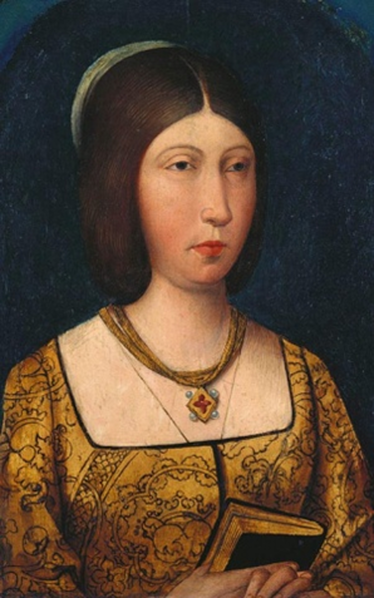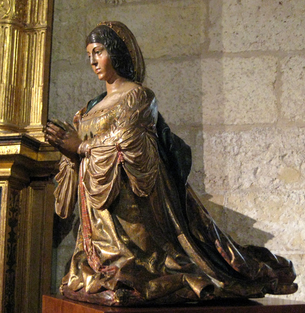 Queen Isabela I of Castile, 1451-1504 CE, Hampton Court Palace, Young Henry Exhibition Room 2, RCIN 403445, Royal Collection Trust/ © Her Majesty Queen
Elizabeth II 2017.
Queen Isabela I of Castile, 1451-1504 CE, Hampton Court Palace, Young Henry Exhibition Room 2, RCIN 403445, Royal Collection Trust/ © Her Majesty Queen
Elizabeth II 2017.
Isabella I of Castile, 1451-1504
Order of Medieval Women Appendix F
Daughter of John II, King of Castile and his second wife Isabella of Portugal, consort to Ferdinand II of Aragon. Isabella’s father died when she was about four leaving his kingdom to her half-brother Henry. The next dozen years Henry proved himself incapable of ruling bringing the country to bankruptcy and imminent ruin. With a civil war brewing Henry asked his sixteen year old half-sister Isabella to agree to not marry without his consent and in turn he would agree to recognize her as his sole heir to the throne, the agreement followed with a proposed marriage to the rebel leader’s brother.
Isabella described in the Castilian chronicles of her time as a beauty, pale complexion, blue eyes and hair a reddish chestnut with a serene expression. With her pure and gentle spirit she had several suitors however Isabella believing a union with her second cousin Ferdinand would be the best for her country wrote her brother asking for consent to marry Ferdinand. Receiving no reply Isabella then sought support from the bishop of Toledo and under his protection in 1469 she defied Henry by first executing their marriage contract which secured her rights to the crown of Castile followed with their marriage. Although not a love match Isabella and Ferdinand grew to be the most devoted of couples, their marriage proving to be one of the most important events in Spanish history as their heir would inherit both the kingdom of Aragon and Castile, forming Spain as it’s known today.
Following her first year of marriage dissatisfied subjects offered Isabella the throne of Castile which she refused stating “.... A fruit which ripens before its time can never last. Ambition to reign has no place in my heart, and I desire that the crown of Castile shall not be mine until death shall have ended the reign of my brother.... “ In 1474, two days after Henry’s death, she proclaimed herself queen of Castile, demonstrating her independent spirit and strength of character that would enable her to rise to power and characterize her sovereign rule of Castile.
Order of Medieval Women Appendix F
Daughter of John II, King of Castile and his second wife Isabella of Portugal, consort to Ferdinand II of Aragon. Isabella’s father died when she was about four leaving his kingdom to her half-brother Henry. The next dozen years Henry proved himself incapable of ruling bringing the country to bankruptcy and imminent ruin. With a civil war brewing Henry asked his sixteen year old half-sister Isabella to agree to not marry without his consent and in turn he would agree to recognize her as his sole heir to the throne, the agreement followed with a proposed marriage to the rebel leader’s brother.
Isabella described in the Castilian chronicles of her time as a beauty, pale complexion, blue eyes and hair a reddish chestnut with a serene expression. With her pure and gentle spirit she had several suitors however Isabella believing a union with her second cousin Ferdinand would be the best for her country wrote her brother asking for consent to marry Ferdinand. Receiving no reply Isabella then sought support from the bishop of Toledo and under his protection in 1469 she defied Henry by first executing their marriage contract which secured her rights to the crown of Castile followed with their marriage. Although not a love match Isabella and Ferdinand grew to be the most devoted of couples, their marriage proving to be one of the most important events in Spanish history as their heir would inherit both the kingdom of Aragon and Castile, forming Spain as it’s known today.
Following her first year of marriage dissatisfied subjects offered Isabella the throne of Castile which she refused stating “.... A fruit which ripens before its time can never last. Ambition to reign has no place in my heart, and I desire that the crown of Castile shall not be mine until death shall have ended the reign of my brother.... “ In 1474, two days after Henry’s death, she proclaimed herself queen of Castile, demonstrating her independent spirit and strength of character that would enable her to rise to power and characterize her sovereign rule of Castile.
|
Isabella initiated a program of reform which reduced the power of her rebellious nobles, streamlined her government, and encouraged scholarship. Intensely religious, she helped establish the Inquisition in Andalusia which led to the expulsion from Spain of over 170,000 Jews, “purifying” the Roman Catholic faith. She was the quartermaster and financier of the 10 year war with Granada which began because of a breach of a truce between the Moors in Granada and Castile. She visited camps to encourage the soldiers and established field and front line emergency tent hospitals which were later known as “Queen’s Hospitals”.
|
When Christopher Columbus sought her financial backing for his search for a shorter route to Asia she initially turned him down as all her funds were being funneled into the war until her Keeper of the Privy Purse reminded her that her goal had been to make her country preeminent in Europe. Summoning Columbus to return she made a contract funding four voyages over the next ten years.
She was a patron of scholars and artists, establishing educational institutions and building a large collection of art works. She learned Latin as an adult, was widely read and educated all her children. Isabella's will, the only writing which she left, is a fascinating document summarizing what she thought were her reign's achievements as well as wishes for the future. Isabella and Ferdinand were buried together at their insistence.
She was a patron of scholars and artists, establishing educational institutions and building a large collection of art works. She learned Latin as an adult, was widely read and educated all her children. Isabella's will, the only writing which she left, is a fascinating document summarizing what she thought were her reign's achievements as well as wishes for the future. Isabella and Ferdinand were buried together at their insistence.
References and Further Reading
- Dunbar, Agnes B., A Dictionary of Saintly Women. George Bell & Sons, London, 1904. archive.org/details/saintlywomen01dunbuoft.
- “Infanta doña ISABEL de Castilla y León ” Foundation for Medieval Genealogy. CASTILE & LEON, COUNTS & KINGS , Chapter 5. KINGS OF CASTILE & leon 1369-1504 (TRASTÁMARA), infante don JUAN de Castilla y León 5. Infanta doña ISABEL de Castilla y León. Web 01 February 2016. //fmg.ac/Projects/MedLands/CASTILE.htm#_Toc359935771.
- Jackson-Laufer, Guida M. Women Who Ruled: A Biographical Encyclopedia. Barnes & Noble Books, 1998.
